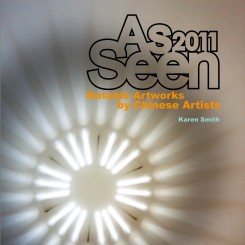CM: Are collectives a way for young artists to get some air?
KS: Certainly seems that way!
CM: Installations and sculptures seem to be dominating the intellectual sphere, including Liu Wei, He Xiangyu and Zhao Yao, but then there is a completely different aesthetic emerging in video and photographic art, such as from Sun Xun, Cheng Ran, Jin Shan, Chen Chieh-Jen and Chen Wei. Is this simply an effect of the medium or a qualitative difference, one of substance and sensibility?
KS: I guess I have got out of the habit of viewing works by materials used to create them, so I don’t see particular art forms dominating the scene — other than in fleeting phases. (Often too fleeting to be significant, instead merely coincidental.) The differences to which you refer in part relate to the substance of certain materials — as we saw last year with what groups were doing with assemblage, with the use of ready-mades, with sculptural forms. All these are limited to a degree by substance, if not form. The same goes for the surface or film or of a photograph. But in the latter context, artists tend to be much more bound by habitual ways of thinking about a particular medium; even where they are refuting an established habit. In China, even rebellion tends to form certain self-evident, recurring habits. I think that’s why photography continues to be largely mediocre as a general practice in art in China. It’s probably more pertinent to say that each younger generation here brings something new to the table—they are part of the ever-changing socio-cultural landscape that is China today and their experience of the world, the influences and information they absorb is vastly beyond what most of us imagine.
CM: Painting — Dead? Alive? Vampiric?
KS: Very much alive, but in small pockets. There’s a swamp of repetitive and formulaic styles, acres of generic form and content, but that is hardly unique to China.
CM: China is still very short on strong institutions for contemporary art, unless we count the handful of serious galleries that attempt to fill that gap. What are the museums and other institutions that give you hope and why?
KS: There are museums like OCT in Shenzhen, Today Art Museum in Beijing, Minsheng Art Museum and the Himalaya Center in Shanghai, etc, which are developing an important voice, but so are regional museums like those in Xi’an, Guangdong and Wuhan. Progress there is slower but the mindset is changing. Galleries continue to do much of the important curatorial endeavor that introduces young artists—which I firmly believe is not the role of a museum—and discovers ideas, trends, styles, etc. There are also an increasing number of personal initiatives to bridge the gaps—like the Arrow Factory in Beijing, James Elaine’s new initiative. Until there are more so-called “neutral” art centers, then this is where the energy will remain concentrated.
CM: Are we more international now?
KS: That’s increasingly like a trick question: in trying to solve its problems, China works to become more international; whilst to solve its problems the international world seeks to become more Asian.
CM: What’s your next project?
KS: The completion of a book that has been too easily neglected. And this year’s edition of As Seen.



